The Indian National Congress released their party manifesto on the 2nd of April, in light of the upcoming general elections. The manifesto is divided into 6 sections that respectively deal with – employment & growth, economy, security & national concerns, governance and institutions, empowerment & justice and welfare. The foreword, written by Rahul Gandhi emphasises on a range of freedoms and seems to be in touch with India’s democratic values.
Also read: National Manifesto Released By Grassroots Muslim Women Activists
So where does the new Congress manifesto stand with regards to women, minorities and justice? The section titled Swabhimaan – Self Esteem for The Deprived is further divided into smaller sections, which begins with women and marginalised castes, and goes on to talk about rights for a range of identities, including the differently-abled, LGBTQIA+ citizens and denotified tribes.

The manifesto is attentive to the recent demands that have been made for social justice and inclusivity, and states that it will work towards land redistribution for Dalits, implement the 33% reservation in parliament for women, withdraw the controversial Trans Bill and exempt aid-devices for differently abled people from the GST. In many parts, the manifesto reflects the understanding that tackling social inequality and deprivation requires solutions that are intersectoral and not horizontal.
The manifesto is attentive to the recent demands that have been made for social justice and inclusivity.
For instance, in regards to women empowerment it promises reform across sectors; including housing, transport, wage-related policy and designing institutions that will be accountable for gender justice The section on SC/ST and OBC citizens similarly approaches historical disadvantage with a promise of structural changes- accessible healthcare and education at all levels, to devising more inclusive curricula and upholding affirmative action.
The Congress manifesto comes across as a text that is committed to social justice. But in crucial points, the wording is vague and it is unclear what the future plan of action is supposed to be. While it is historic for the manifesto of a political party to discuss LGBTQIA+ rights, it only mentions ‘gender sensitivity’ and ‘rights’ in arbitrary ways. The conception of LGBTQIA+ rights seems to be shallow, as it does not discuss the scope and range of rights that must be secured for gender and sexual
A report in
The conception of LGBTQIA+ rights seems to be shallow, as it does not discuss the scope and range of rights that must be secured for gender and sexual minorities
Finally, the progressive ethos of secularism, inclusivity and social justice in the Congress manifesto feels out of touch with the kind of soft-Hindutva slant that the party has been moving towards in the past months. The increasing focus on cow protection escalated in Congress-ruled Madhya

In a similar vein, the Congress election campaign in parts of Karnataka was marked with Hindu metaphors, saffron imagery and quotes from the Bhagwat Gita – a far cry from the secular spirit that their manifesto communicates. In the wake of the Sabarimala judgement, the Congress in Kerala was largely against granting women access into the temple – a stance which is ironic when the very forward of the manifesto upholds the freedom to
Also read: The Crimes of Kamal Nath: The Closed Chapter of Anti Sikh Riots That Must be Revisited
At a time when the ruling party has been systematically eroding rights and freedoms, especially that of minorities, the Congress manifesto does look compelling on paper. But as the new-normal becomes less constitutional and tilts towards Hindutva politics, one can’t help but look at the cover title of the manifesto and wonder: will they deliver?
Featured Image Source: The Indian Express
About the author(s)
Anagha is pursuing her MA in Media & Culture from TISS Mumbai.




